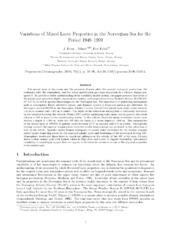Variations of Mixed Layer Depth and Water Properties in the Norwegian Sea for the period 1949-1999
Peer reviewed, Journal article
Accepted version

View/
Date
2006-06-08Metadata
Show full item recordCollections
- Geophysical Institute [1189]
Original version
https://doi.org/10.1016/j.pocean.2006.03.014Abstract
The mixed layer of the ocean and the processes therein affect the ocean’s biological production, the exchanges with the atmosphere, and the water modification processes important in a climate change per- spective. To provide a better understanding of the variability in this system, this paper presents time series of the mixed layer properties depth, temperature, salinity, and oxygen from Ocean Weather Station M (OWSM; 66◦ N,2◦ E) as well as spatial climatologies for the Norwegian Sea. The importance of underlying mechanisms such as atmospheric fluxes, advective signals, and dynamic control of isopycnal surfaces are addressed. In the region around OWSM in the Norwegian Atlantic Current (NwAC) the mixed layer depth varies between ~20 m in summer and ~300 m in winter. The depth of the wintertime mixing here is ultimately restrained by the interface between the Atlantic Water (AW) and the underlying water mass, and in general, the whole column of AW is found to be mixed during winter. In the Lofoten Basin the mean wintertime mixed layer reaches a depth of ~600 m, while the AW fills the basin to a mean depth of ~800 m. The temperature of the mixed layer at OWSM in general varies between 12◦ C in summer and 6◦ C in winter. Atmospheric heating controls the summer temperatures while the winter temperatures are governed by the advection of heat in the NwAC. Episodic lateral Ekman transports of coastal water facilitated by the shallow summer mixed layeris found important for the seasonal salinity cycle and freshening of the northward flowing AW. Atmospheric freshwater fluxes have no significant influence on the salinity of the AW in the area. Oxygen shows a clear annual cycle with highest values in May–June and lowest in August–September. Interannual variability of mixed layer oxygen does not appear to be linked to variations in any of the physical properties of the mixed layer.